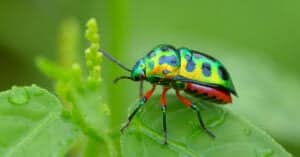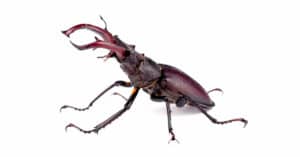There are between 170 and 180 types of beetles native to Wisconsin. That may not sound like much, but the order of Coleoptera makes up the largest group of animals in the world. There are certainly more than enough beetles to go around in Wisconsin.
Wisconsin is a beautiful state, and it’s easy to spend more time looking around than it is exploring the tiny insects that inhabit the land. Sure, some beetles are incredibly destructive, whether it’s damage to synthetic structures or the natural environment itself.
However, for the most part, beetles are a necessary part of the ecology, feeding the soil, facilitating natural decay, pollinating, and ridding local areas of nuisance insects. From the American oil beetle to the Carolina Pine Sawyer, here are ten beetles native to Wisconsin.
1. Calligrapha Beetle

Since they love grass and low-lying plants so much, you’re liable to find them in the yard or hitching a ride on your pet dog.
©WuTang.Photographer/Shutterstock.com
Now, this is a pretty neat beetle to kick things off with. It resembles the standard ladybug, but it’s a little bigger at .4″. The calligrapha beetle is not destructive; the worst it might do is help you mow your lawn.
They love to eat grass, dandelions, and other plants growing close to the ground. They might give your flower garden a little trouble from time to time but nothing too crazy. They have similar wing shapes and patterns to ladybugs, but the red on their wings is a faded or broken color. Instead of neat little black dots, they’re more like splotches.
Since they love grass and low-lying plants so much, you’re liable to find them in the yard or hitching a ride on your pet dog. Don’t worry; they aren’t dangerous to your dogs, cats, or home.
2. American Oil Beetle
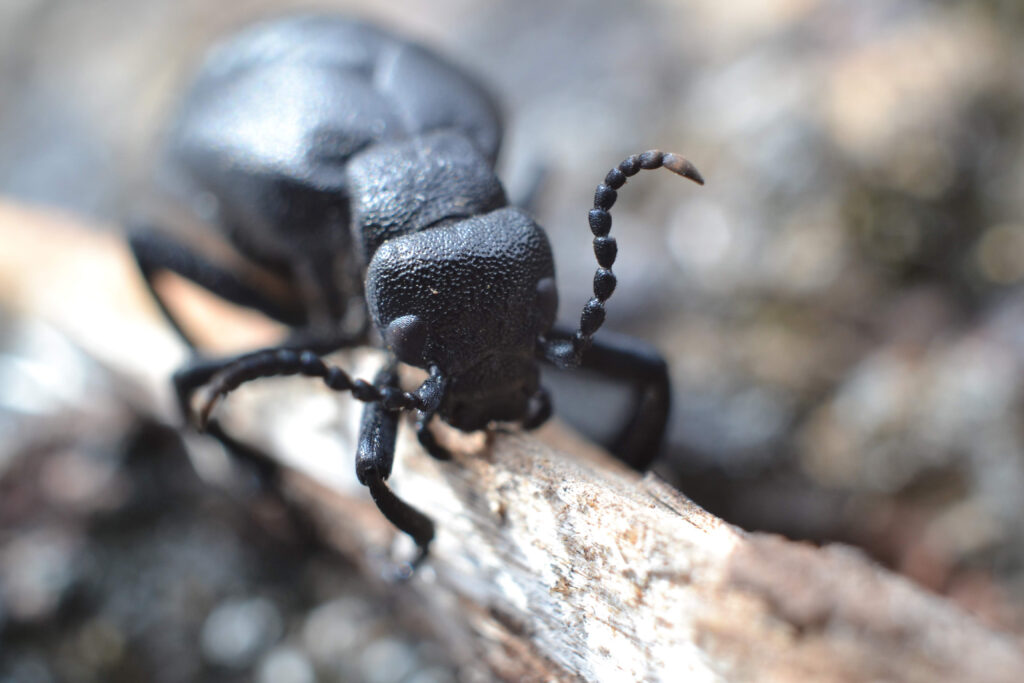
These beetles are effective pollinators, feeding on pollen and nectar most of their days.
©Bernadette Davis/Shutterstock.com
The American oil beetle is a member of the blister beetle family, which means you should probably leave it alone if you cross its path. Blister beetles secrete a defensive chemical that can cause anything from light burns to serious blisters.
As their name implies, they are all black, with the occasional amber splotch or orb-like attachment. Though rare, some American oil beetles are a dark orange color, rather than black. They’re effective pollinators, spending most of their days feeding on pollen and nectar.
So long as you don’t touch it and just let it do its thing, an American oil beetle should be welcome in your flower garden. Since they also kill and eat aphids and other destructive bugs, the benefits of an oil beetle in your garden are twofold.
3. Case Bearing Life Beetle
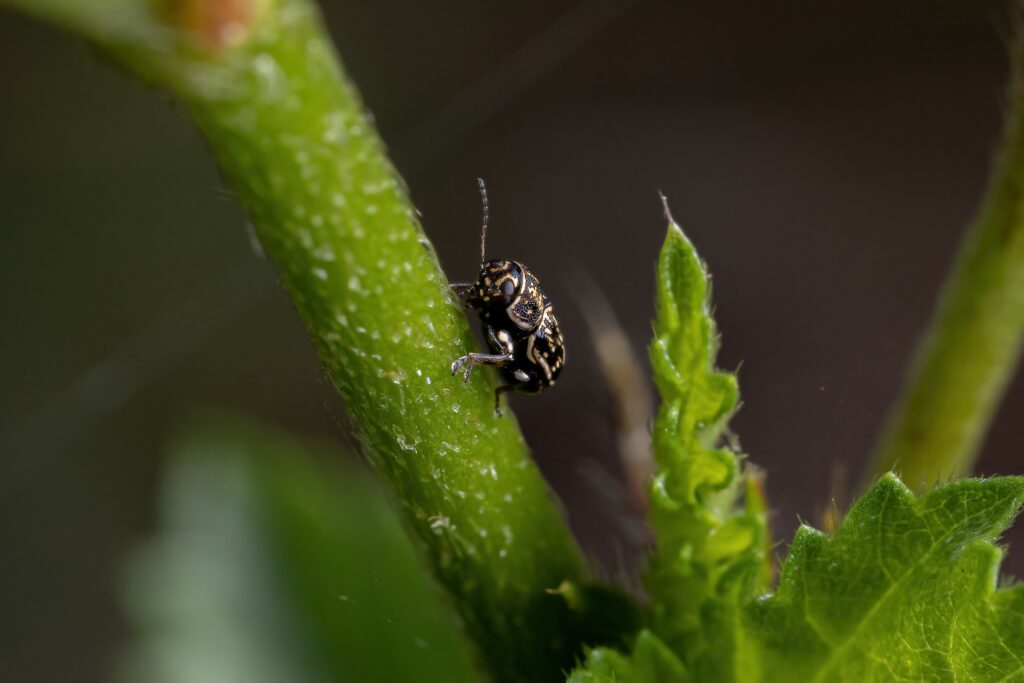
Case Bearing Life Beetle adult males can reach a little over 1/4″ in length, so they aren’t the largest beetles native to Wisconsin.
©Vinicius R. Souza/Shutterstock.com
This beetle should win the award for the most intriguing name of the week. No, case-bearing life beetles don’t carry cases around with them, but it does look like their bottom half is permanently encased in a cocoon.
In reality, it’s just the way their abdomens look. This “case” is a rigid construction with a bumpy, grain-like texture. The thorax and head are usually bright and vivacious orange. In other words, it looks like a fairly interesting and colorful insect attempting (and failing) to emerge from its case.
The best part is they build their cases—using their feces. Beetles are endlessly entertaining. Adult males can reach a little over 1/4″ in length, so they aren’t the largest beetles native to Wisconsin. But they’re probably one of the most unique.
4. Carolina Pine Sawyer

The Carolina Pine Sawyer’s antennas are twice the length of their bodies, which makes them instantly recognizable.
©Brett Hondow/Shutterstock.com
This beetle stands out from the crowd thanks to its exceptionally long antennae. They get at least a portion of their name thanks to their propensity for feeding on pine trees. Fortunately, their feeding habits do little more than stress the tree out a little bit.
The problem is the secondary effects. A Carolina pine sawyer typically carries several nematodes on its body. Once the pine sawyer is done with its mean, the nematodes detach and enter through the tree’s fresh wound. Now, the pine tree is infected with nematodes, and the danger to the tree is exponentially higher.
Classified as a longhorn beetle, the Carolina Pine Sawyer is a victim of the friends it keeps. They’re a dusky brown color with a texture resembling the very bark they feed on. Their antennae are twice the length of their bodies, which makes pine sawyers instantly recognizable.
5. Clay-Colored Billbug
We had to squeeze a weevil in here somewhere, and the clay-colored billbug’s number came up. This interesting little creature has a snout that’s eerily similar to an anteater. The majority of their distinct coloration is a dark, glossy brown.
However, the patterning on their shell includes a series of vertical, cream-colored lines. The “bill,” or mouth, if you choose to call it that, is entirely black. It might be considered an intimidating insect to some, but it’s generally harmless, feeding on tall grasses and reeds.
Since Lake Superior and Lake Michigan, of the Great Lakes fame, sit right up against Wisconsin, there is plenty of territories for the clay-colored billbug to explore and feed in.
6. American Carrion Beetle

American Carrion beetles smell decay, sometimes miles away, and will instinctively fly to it.
©Jay Ondreicka/Shutterstock.com
The American carrion beetle is one of the widest beetles on our list, with a yellow head and a black body. Its wings are large, making up the entirety of the carrion beetle’s body, with the lone exception of the head. The wings are also heavily textured, like freshly poured, unfinished concrete.
Their yellow heads have a distinct, fuzzy, black dot, shaped sort of like a star, directly in the center. They mostly get through life eating fungi and rotten fruit, long ago fallen from some tree. However, as their name implies, they are more than happy to feed on the flesh of dead animals.
American Carrion beetles smell decay, sometimes miles away, and will instinctively fly to it. Not only do they feed on it, but they’ll also lay their eggs there, providing their newborns with a host to feed on as they grow and morph.
7. Black Caterpillar Hunter
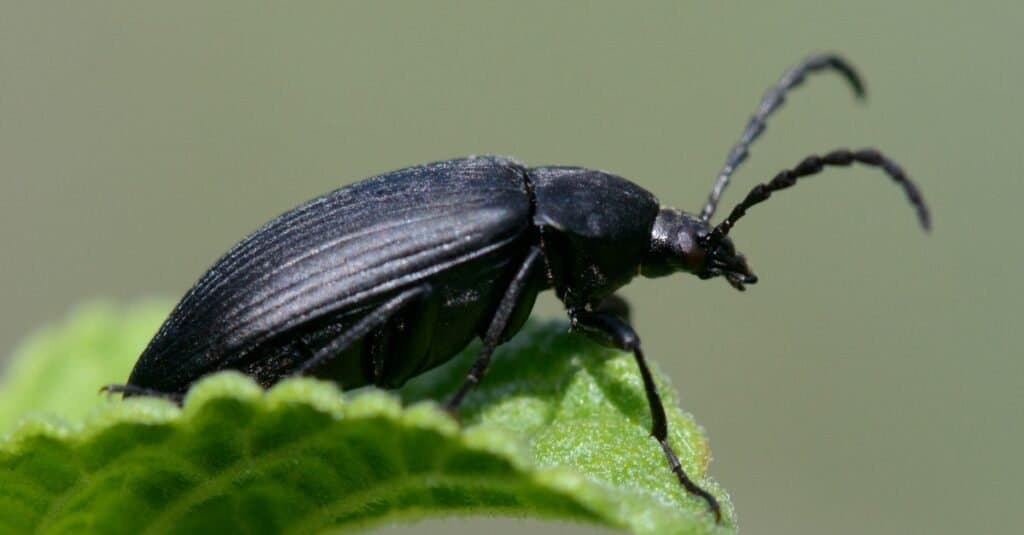
Black
Caterpillar
Hunter beetles live in woodlands and gardens in the southern United States.
©iStock.com/MichaelRLopez
While it may sound like a cool movie, the black Caterpillar hunter is a pretty ordinary-looking beetle. It’s all black with an oval-shaped abdomen. On closer inspection, a series of lines run vertically from the beginning of their segmentation to their back end.
There’s also a series of little dots running parallel to the stripes. These dots are often orangish or faded red and are so tiny they’re easy to miss. They’re fairly large, often reaching a little over a half-inch. They received their namesake for their top choice in food—caterpillars.
While a black caterpillar hunter will spend most of its life crawling along the ground, feeding on leaves, grass, and other debris, it will kill and consume caterpillars on sight. They only eat them, however, with the female preferring to lay eggs in the dirt rather than inside a caterpillar carcass.
8. Bicolored Flower Longhorn
There are a ton of beetles native to Wisconsin, so it only makes sense to get a flower longhorn in here somewhere. This particular version is the bicolored flower longhorn, and it’s a doozy. This longhorn type is a very long, more graceful member of the beetle family and has exactly two colors.
The abdomen section is entirely black, and the longhorn has amber-colored legs, a head, a thorax, and the very back tip of the body. In a way, they resemble a praying mantis without the intimidation factor and the large size.
It’s a great pollinator, so they should be warmly welcomed into your garden. But, when it comes time to breed and lay eggs, the female heads out to the woods. Bicolored flower longhorn larvae feed on dead bark and need more than a garden to grow.
9. Bee-Like Flower Scarab Beetle
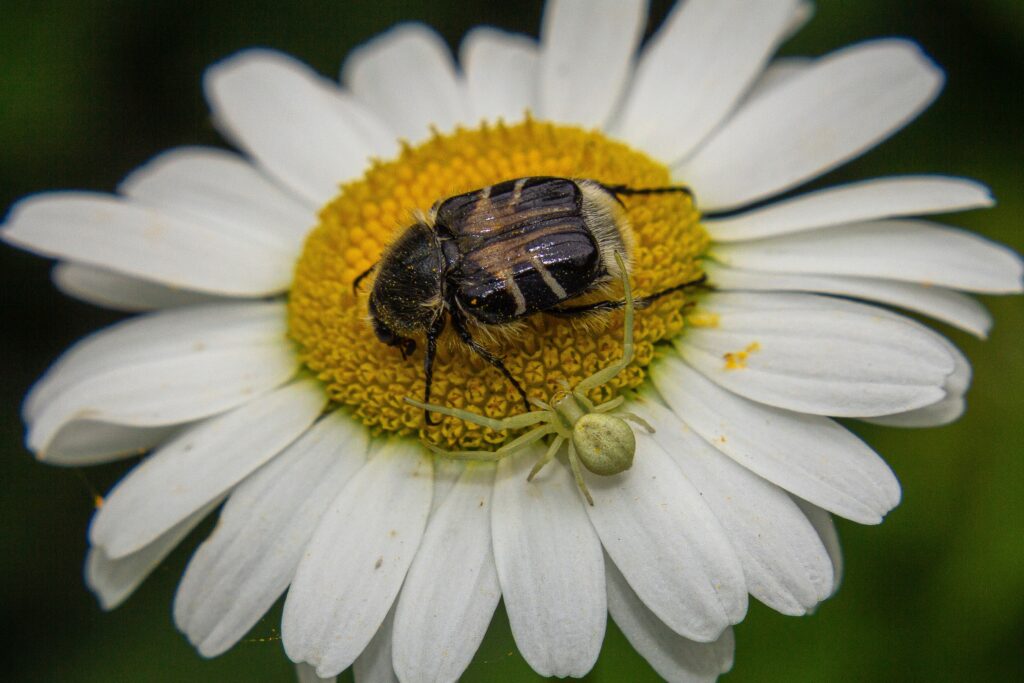
A bee-like flower scarab is about to get attacked by a flower
crab spider
.
©Sara Cibaj/Shutterstock.com
The bee-like flower scarab beetle resembles the large bumblebees that tend to come out in droves at the very beginning of springtime. This scarab beetle even has the fine hairs and colorations of a typical bumblebee.
It’s mostly black with yellow and black bands across its body. This coloration is a defensive mechanism, tricking potential predators into thinking the beetle is a stinging bumblebee. When most birds and other predators see the bee-like flower scarab beetle, they wisely move on.
Also, like bumblebees, bee-like flower scarabs are pollinators, feeding primarily on nectar and pollen. Their young mostly feed on whatever organic matter they can get ahold of.
10. Banded Net-Winged Beetle

The banded net-winged beetle is mostly harmless, feeding on various plants and grasses.
©EM-80/Shutterstock.com
Not only does it sound pretty cool, but the banded net-winged beetle also has an impressive look. Its wings feature two large orange bands and two equally large black bands. The head flips the bands from the horizontal pattern on its wings to a vertical pattern, with a single, central black band flanked by orange.
Unfortunately, their pupae are nowhere near as impressive looking. They have to grow into their looks. The banded net-winged beetle is mostly harmless, feeding on various plants and grasses.
Their bodies are loaded with chemicals that taste awful to various potential predators.
Final Thoughts
There are more beetles in this world than any other lifeform. The same holds in Wisconsin, where beetles of every color, stripe, shape, and form flourish in the local environments. Wisconsin is also home to various unique beetles, both in terms of names and appearance.
Some of the beetles native to Wisconsin harm the environment and people. However, most beetles that call Wisconsin home are harmless and fantastic to observe. Just be careful which ones you pick up with your bare hands.
The photo featured at the top of this post is © EM-80/Shutterstock.com
Thank you for reading! Have some feedback for us? Contact the AZ Animals editorial team.



